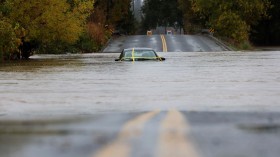
New research suggests that underwater volcanic explosions may certainly produce Washington Capitol dome-sized bubbles. It revealed an incredible side effect of intense magma eruptions at the bottom of the sea.
John Lyons, a geophysicist from the US Geological Survey's Alaska Volcano Observatory, along with his team, investigated records of low-frequency sound. They found out that Bogoslof volcano's underwater near Alaska could produce more than 70 explosive eruptions between 2016 and 2017. Their research was published in the journal Nature Geoscience.
Bogoslof's eruptions are rarely seen due to its remote location. However, historical accounts tell rich stories of how it resembles as a submerged volcano lets lose.
A report published in a USGS journal witnessed a "colossal soap bubble" rising out from Albatross in 1908. It showed "gigantic clouds of smoke and steam." Another report, published in the same USGS journal, observed a "gigantic dome-like swelling" of water. It is "as large as the dome of the capital at Washington that subsided and rose again."
The observatory's microphones recorded a strange, low-and-slow melody, which was repeated over 250 times throughout the nine months that the volcano remained active. Lyons added some of these "really low frequencies" had periods up to 10 seconds.
The authors explained in their paper that the infrasound arose from the vibrations and magmatic gas bubbles which initially formed from submerged vents. However, those never grew and burst above sea level.
Researchers modeled the low-frequency signals as the highly pressurized gas bubbles grew near the water–air interface. They added it required bubble radii of 50 to 220 meters.
These harmful, gassy volcano bubbles, if the researchers calculated it correctly, may extend over 1,400 feet (approximately 440 meters) in diameter. It would be the same height as Malaysia's Petronas Towers and yields a large volume that could consume the Great Pyramids of Giza.
"It is hard to imagine a bubble so big. But the volumes of gas that we calculated to be inside the bubbles are similar to the volumes of gas that have been calculated for [open air] explosions," Lyons said in Discover Magazine.
The findings described the first time such movement was recorded with infrasound monitoring, which detects sound waves traveling in the air below the threshold of human hearing. Researchers are shifting to the monitoring method as a way to improve traditional seismic data and obtain more data into the dynamics of an eruption.
Jeffrey Johnson, a geophysicist at Boise State University in Idaho who was not involved in the study, found the research "groundbreaking and impactful." "Giant bubbles which defy the imagination [can] oscillate and produce [a] sound that you can record several kilometers away," he told Discover Magazine.
But Lyons expects to have a follow-up task through investigating the dynamics of related and more approachable methods that are directly observable in the upcoming studies. He envisions monitoring or recording the sounds from these types of bubbles to validate specific hypotheses they had to make in their model, such as the thickness of the water in the area.
© 2024 NatureWorldNews.com All rights reserved. Do not reproduce without permission.





